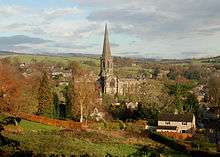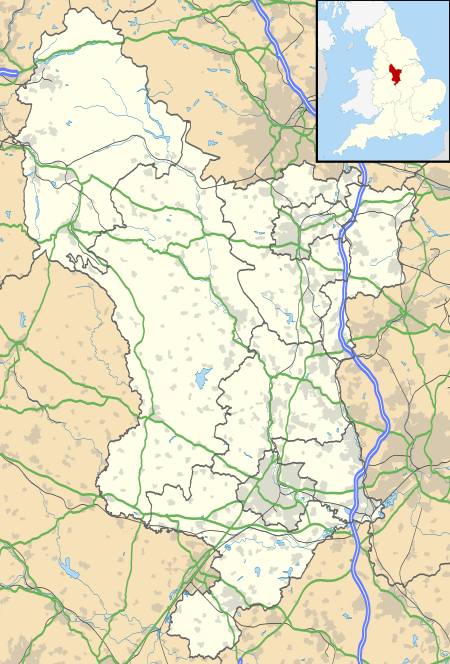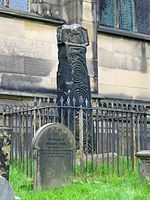All Saints' Church, Bakewell
All Saints' Church, Bakewell, is the parish church of Bakewell, Derbyshire. It is a Grade I listed building.[1]
| All Saints’ Church, Bakewell | |
|---|---|
 All Saints’ Church, Bakewell | |
 All Saints’ Church, Bakewell Location within Derbyshire | |
| 53°12′46.44″N 1°40′42.96″W | |
| Location | Bakewell, Derbyshire |
| Country | England |
| Denomination | Church of England |
| Website | bakewellchurch.co.uk |
| History | |
| Founded | 920 |
| Dedication | All Saints |
| Architecture | |
| Heritage designation | Grade I listed[1] |
| Administration | |
| Parish | Bakewell |
| Deanery | Bakewell & Eyam[2] |
| Archdeaconry | Chesterfield |
| Diocese | Derby |
| Province | Canterbury |
| Clergy | |
| Vicar(s) | Anthony P. Kaunhoven |
The first church

The church was founded in 920, during Anglo-Saxon times and the churchyard has two 9th-century crosses. During restoration work, in the 1840s, many carved fragments of Anglo-Saxon stonework were found in and around the porch, as well as some ancient stone coffins.
The present church
The present church was started in the 12th century in Norman style; however, only the west front and part of the nave survive from that time. The remainder of the church was built between 1220 and 1240. The spire was added in 1340 but, was taken down in 1825, and the tower also removed in 1830.[3] Before the restoration work the church measurements were from the level of the church floor to the top of the spire 180 feet (55 m), from east to west 153 feet (47 m), transepts from north to south 106 feet (32 m).[3]
Between 1841 and 1844, it was almost completely rebuilt as it had become dangerous. as part of the restoration by William Flockton.[4] Once the external works were completed in 1844, internal restorations were undertaken. The church was re-pewed throughout. The Norman piers from the nave were substituted for early English decorated ones, and steam heating was introduced. This work was carried out by Mr Bath of Haddon under the supervision of the architects John Grey Weightman and Matthew Ellison Hadfield of Sheffield. The church re-opened on 4 September 1851.[5]
The chancel was restored between 1879–82 by George Gilbert Scott Jr.. The restoration was carried out at the expense of the Ven. Archdeacon Balston, vicar, with the outside walls being paid for by the Ecclesiastical commissioners. A new screen was provided under the chancel arch, with carving mimicking that on the screen in the Vernon Chapel. A new pavement of marble was laid. In the sanctuary, a new reredos was installed, with an engraving of the scene on Mount Calvary. The woodwork was done by Mr Elwell of Beverley. The walls by Burlison and Grylls, the floor by Belham of Buckingham Palace Road, London and the marble work by Twigg of Ashford.[6]
A north vestry was added in 1897–98 at a cost of £700 (equivalent to £78,600 in 2019).[7] The architects were Naylor and Sale of Derby, and the contractor T. Allsop and Son of Bakewell. The vestry was fitted out with furniture from Booth and Wright of Bakewell, and the woodwork was installed by Groom and Co of Bakewell and Matlock.[8] It was dedicated by the Bishop of Southwell on 15 May 1898.
In 1906 – 07 the nave roof was repaired by Charles Hodgson Fowler. He fixed a large crane on an elevated timber platform just over the roof of the south porch, and covered the nave with a temporary iron roof. The crane was used to remove the old roof timbers. Oak trees from Holton Park, Oxfordshire were selected for the new roof timbers. Hodgson Fowler also replaced the tie beams and the wall plates. The cost of restoration was £445[9] (equivalent to £47,400 in 2019).[7]
Misericords
All Saints' contains three early-15th-century misericords, along with eighteen 19th-century misericords in the choir stalls. Additionally, there is one 19th-century misericord on a priest's seat. The 19th-century misericords date from 1881.
Relics and monuments

The church has some interesting relics of the Vernon and Manners families as well as a fine 14th-century baptismal font. In the Vernon Chapel (off the South aisle) there are several magnificent tombs: Sir Thomas Wendesley (killed at the Battle of Shrewsbury in 1403; John Vernon of Haddon Hall, who died in 1477; and Sir George Vernon and his two wives.[10]
Sir George, nicknamed 'King of the Peak',[11] died in 1567, is famous as the father of Dorothy Vernon, who eloped with Sir John Manners, both of whom have a monument at the South end of the chapel. There is also a monument to their son, George Manners and his wife Grace.
Outside the chapel is a much smaller 14th-century alabaster monument to Sir Godfrey de Foljambe and his wife Avena.[10] The monument is said to be very rare, with only two of that age surviving to the present day. It shows Foljambe and his wife as if they are looking out of a window and this can still be seen on the south wall.[12] Below the mural is an explanatory inscription, but this dates from only 1803 and was "added by Mr Blore".[10]
Stained glass
- North aisle window of 1893 by Henry Holiday[1] depicting Saints and Angels adoring the Lamb of God
- North aisle window by Charles Eamer Kempe[1] depicting St George and St Hubert
- Chancel east window of 1892[1]
- North transept window of 1881 by Hardman & Co.[1]
- Resurrection window in Vernon Chapel, 1859 also by Hardman & Co.[1]
- South transept south window, 1851 by William Wailes.[5]
Vicars of Bakewell
The majority of this list is taken from an article in the Sheffield Independent on 30 July 1901.[13]
- Henry of Lexington. Rector. Dean of Lincoln 1253
- Peter, Rector 1254
- Robert, Vicar, 1272
- John de Osmundeston 1286–1323
- Robert Bernard 1327–1331
- Walter de Newton 1331
- Gervase de Hassop 1333–1343
- William de Snell
- William de Kyrtelington 1349–1365
- Roger de TIbshelf 1365–1405
- John de Burton 1409–1418
- John Huckyns 1424
- Thomas Stavndon 1428
- William Brome 1435–1439
- Richard Crichelowe 1457–1469
- Thomas Crichelowe 1474
- Thomas Heyward 1481–1493
- Thomas Forte 1493–1494
- William Massey 1494
- John Wilcock 1511–1512
- Richard Hoton 1512–1533
- Richard Gwent 1533–1537
- Edmund Webster 1537
- Ralph Clayton 1569–1605
- Edmund Clayton 1605
- Hamlet Charlton 1609–1614
- John Rowlandson 1615–1649
- John Rowlandson Jun. 1650–1662
- John Beardmore 1662–1668
- Christopher Lawson 1668–1672
- Edward Smith 1672[14]–1673
- Thomas Wilson 1673–1708
- Gorstelow Monck 1708–1724
- Jonathan Birch 1724–1735
- Thomas Grove 1735[15]–1769
- Richard Weston 1769
- Richard Chapman 1769–1816
- Francis Hodgson 1816[16]–1840 Archdeacon of Derby
- Hubert Kestell Cornish 1840–1869
- Edward Balston 1869–1891 Archdeacon of Derby
- Charles F. Thornewill 1892[17]–1894
- Edward T. Billings 1894–1897[18]
- Charles T. Abraham 1897–1918
- Edmund Spink 1919–1931
- Arthur E.J.B. Barrow 1931–1938
- Norman S. Kidson 1939–1955
- George Sinker 1955–1962
- Charles R. Heywood 1962–1973
- Edmund R. Urquhart 1973–2005
- Anthony P. Kaunhoven 2007–current
Organ

The organ dates from 1810 when a "finger organ"[19] by J Lincoln was installed. This was rebuilt in 1851 by William Hill,[5] but this appears to have been unsatisfactory as it was rebuilt again in 1859[20] and again in 1883 by Brindley & Foster.[21] Further work by Jardine and Co in 1954 and George Sixsmith in 1989 have left the church with a 3 manual 42 speaking stop pipe organ. A specification of the organ can be found on the British Institute of Organ Studies National Pipe Organ Register at N00212.
Organists
- John Fritche 1846–1860
- Mr. Craddock of Truro 1860[22]–1864
- Mr. Hopper 1864–1868
- W.H. Marsden 1868–1869
- Frederick Burgess 1869[23]–1873
- C.C. Mitchell 1873[24]–1877
- Thomas Barker Mellor 1877–1913
- G.C.E. Eyres 1913[25]–???? (formerly organist of Walsall Parish Church)
- W.E. Cave 1913[26]–1932 (afterwards organist of Whitby Parish Church)
- T.H. Mosley 1932[27]–???? (previously organist of St Peter's Church, Edensor, Derbyshire)
- Glyn Davies 1982–????
The church today
Today, along with its regular religious services, the church is an important building in the town and the wider Peak District. It is used for, amongst other things, concerts by Bakewell Choral Society and the annual Commemoration service of Lady Manners School when they staff and pupils give thanks to Grace, Lady Manners, for founding their school in 1636.
The church website has much more information about the ongoing life and worship of the parish, including forthcoming services and other events.
Parish status
The church is in a joint parish with:
- Holy Trinity Church, Ashford-in-the-Water
- St Anne's Church, Over Haddon
- St Katherine's Church, Rowsley
- St Michael and All Angels' Church, Sheldon
Gallery
 9th-century cross in the churchyard
9th-century cross in the churchyard
References
- Historic England, "Church of All Saints (1316489)", National Heritage List for England, retrieved 4 March 2017
- "All Saints, Bakewell". A Church Near You. The Church of England. Retrieved 4 March 2017.
- "Observations on the Antiquities of the Parish Church of Bakewell". Derbyshire Courier. England. 2 April 1842. Retrieved 4 March 2017 – via British Newspaper Archive.
- English Heritage (1951) Church of All Saints. Images of England (Retrieved 22 January 2006—free registration required).
- "Re-opening of Bakewell Church". Derby Mercury. England. 10 September 1851. Retrieved 4 March 2017 – via British Newspaper Archive.
- "The restoration of the Chancel of Bakewell Church". Derbyshire Times and Chesterfield Herald. England. 6 May 1882. Retrieved 4 March 2017 – via British Newspaper Archive.
- UK Retail Price Index inflation figures are based on data from Clark, Gregory (2017). "The Annual RPI and Average Earnings for Britain, 1209 to Present (New Series)". MeasuringWorth. Retrieved 2 February 2020.
- "Bakewell Parish Church. Dedication of the New Vestry". Derbyshire Times and Chesterfield Herald. England. 21 May 1898. Retrieved 4 March 2017 – via British Newspaper Archive.
- "Bakewell Church Restoration". Derbyshire Courier. England. 28 April 1906. Retrieved 4 March 2017 – via British Newspaper Archive.
- 'Parishes: Bakewell', Magna Britannia: volume 5: Derbyshire (1817), pp. 23–43. URL: http://www.british-history.ac.uk/report.aspx?compid=50721 Date accessed: 30 August 2013
- King of the Peak
- Gardner, Arthur (2011). Alabaster Tombs of the Pre-Reformation Period in England. Cambridge University Press. p. 13. ISBN 0521166209.
- "Vicars of Bakewell". Sheffield Independent. England. 30 July 1901. Retrieved 4 March 2017 – via British Newspaper Archive.
- "Edward Smith". Online Clergy Database. Retrieved 4 March 2017.
- "Thomas Grove". Online Clergy Database. Retrieved 4 March 2017.
- "Francis Hodgson". Online Clergy Database. Retrieved 4 March 2017.
- "Induction of the new Vicar of Bakewell". Derbyshire Advertiser and Journal. England. 13 May 1892. Retrieved 4 March 2017 – via British Newspaper Archive.
- "Resignation of the new Vicar of Bakewell". Derbyshire Times and Chesterfield Herald. England. 28 August 1897. Retrieved 4 March 2017 – via British Newspaper Archive.
- Barrel organ: the story of the mechanical organ and its repair. Arthur W. J. G. Ord-Hume. 1978
- "Re-opening of the organ in Bakewell Church". Derby Mercury. England. 7 December 1859. Retrieved 4 March 2017 – via British Newspaper Archive.
- "Opening of a new organ at Bakewell Church". Derbyshire Times and Chesterfield Herald. Chesterfield. 12 May 1883. Retrieved 23 April 2015.
- "Bakewell". Derby Mercury. England. 24 October 1860. Retrieved 4 March 2017 – via British Newspaper Archive.
- "Bakewell". Derbyshire Advertiser and Journal. England. 31 December 1869. Retrieved 4 March 2017 – via British Newspaper Archive.
- "Election of Organist". Derbyshire Times and Chesterfield Herald. Chesterfield. 1 February 1873. Retrieved 23 April 2015.
- "New Organist at Bakewell Church". Derby Daily Telegraph. Derby. 4 October 1913. Retrieved 23 April 2015.
- Frederick W Thornsby. Dictionary of organs and organists. 1913
- "Organist at Bakewell". Derbyshire Times and Chesterfield Herald. Chesterfield. 10 September 1932. Retrieved 23 April 2015.